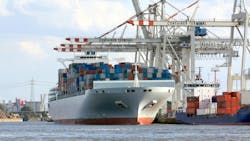Asia-to-North America Shipping on Upswing
Shipping via the Middle East remains plagued by issues, but container ship traffic from Asia to North America is up, says shipping industry consultant Drewry.
Simon Heaney, Drewry’s senior manager, container research, provides more detail in this MTD exclusive. (Based in the United Kingdom, Drewry also has offices in China, India and Singapore.)
MTD: Several months ago, continued attacks on container ships in the Red Sea forced companies to divert vessels away from the Suez Canal, causing delays and other issues. What's the situation now?
Heaney: The Suez Canal never formally closed, but carriers had to decide if the risk was worth it. Drewry’s Automatic Identification System ship tracking data shows that containerships transits of the Suez Canal were down by 68% year-over-year in the first two months of 2024. When measured by ship capacity, the decrease was larger still, at minus-81%.
In many cases when ships do use the canal, carriers send them no further south than Jeddah in Saudi Arabia before heading back north so not to run the gauntlet of passing through the Bab al-Mandab Strait, where the Houthis are camped out.
The risk of attack has not abated and we expect this holding pattern (i.e. most ships sailing around the Cape with a handful of Suez/Bab al-Mandab transits) to continue at least through the end of 2024.
MTD: What's the state of shipping from Asia to North America, across the Pacific? Are we continuing to see bottlenecks at the Panama Canal?
Heaney: Demand in the eastbound Asia to North America container market is growing briskly. Asia-West Coast traffic is up 26% year-over-year. Some of this is due to a low base in 2023, but the growth rates are superior to other major trading corridors. The Panama Canal is loosening its daily transit and draft restrictions due to more rainfall. It expects to be back to normal operations by the end of this year.
MTD: What are you seeing when it comes to freight rates - in particular, from Asia to North America?
Heaney: Initial information we have indicates that secured rates are lower when comparing year-over-year. However, it does depends on where your starting point is, as some shippers renegotiated contracts at lower levels during the previous year and therefore may not see much change.
MTD: What's the state of container ship inventory and available container ship capacity as we close in on the mid-year mark? What do you expect to see during the second half of 2024?
Heaney: The containership fleet is expected to grow by 8% this year, way in advance of anticipated demand growth (circa 2-3%). This only adds to the accumulated overcapacity in the market and is the reason why freight rates are falling, despite the increased disruption.
